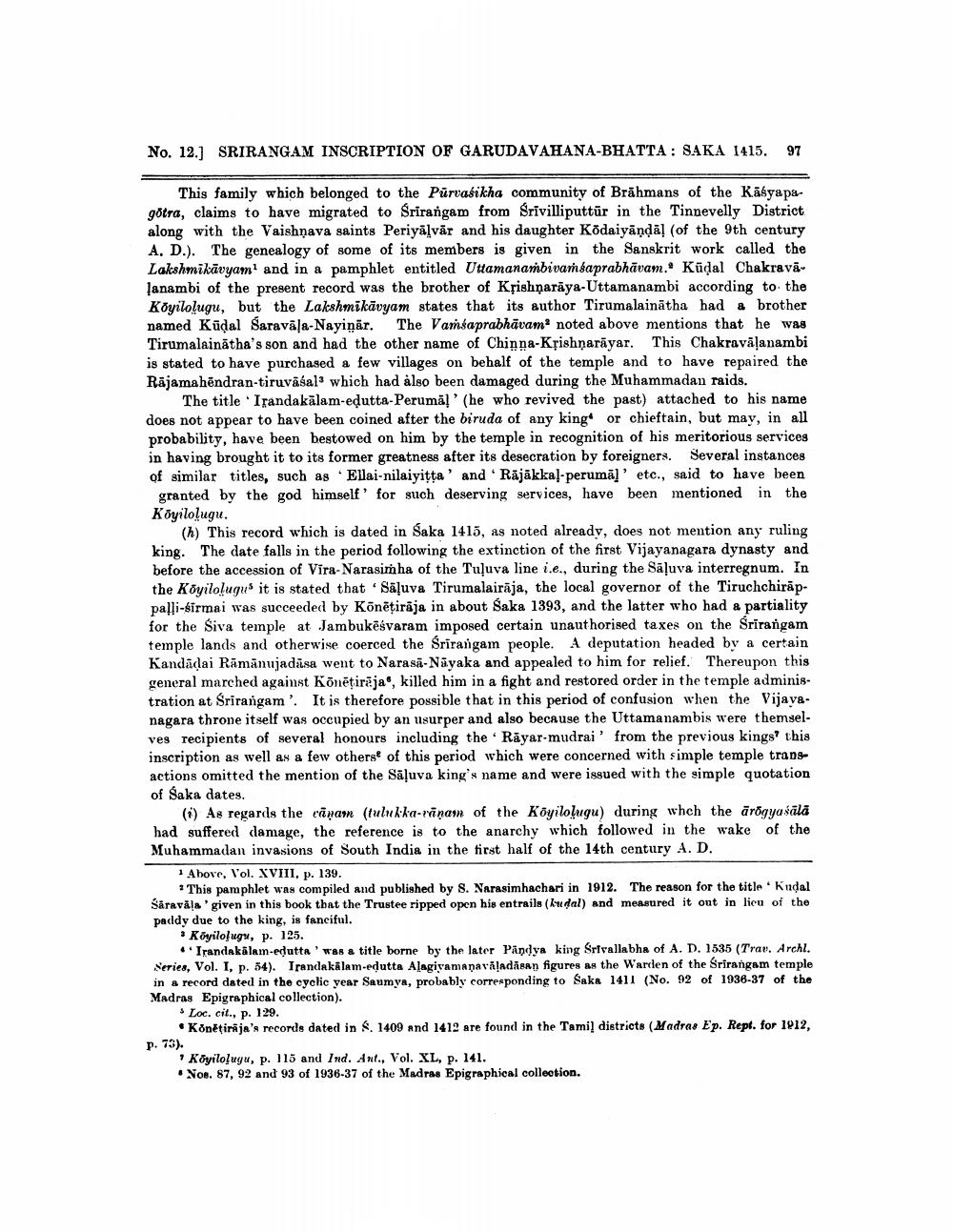________________
No. 12.) SRIRANGAM INSCRIPTION OF GARUDAVAHANA-BHATTA: SAKA 1415. 97
This family which belonged to the Purvasikha community of Brāhmans of the Kabyapagötra, claims to have migrated to Srirangam from Srivilliputtar in the Tinnevelly District along with the Vaishnava saints Periyālvār and his daughter Ködaiyandal (of the 9th century A. D.). The genealogy of some of its members is given in the Sanskrit work called the Lakshmikāvyam' and in a pamphlet entitled Uttamanaṁbivam saprabhāvam. Küdal Chakravā. lanambi of the present record was the brother of Krishộarāya-Uttamanambi according to the Koyilolugu, but the Lakshmikävyam states that its author Tirumalainātha had a brother named Kūdal Saravāla-Nayinār. The Vamsaprabhāvama noted above mentions that he was Tirumalainātha's son and had the other name of Chinna-Kțishộarāyar. This Chakravāļanambi is stated to have purchased a few villages on behalf of the temple and to have repaired the Rajamahēndran-tiruvāśal: which had also been damaged during the Muhammadan raids.
The title Irandakälam-edutta-Peruma!' (he who revived the past) attached to his name does not appear to have been coined after the biruda of any king or chieftain, but may, in all probability, have been bestowed on him by the temple in recognition of his meritorious services in having brought it to its former greatness after its desecration by foreigners. Several instances of similar titles, such as Ellai-nilaiyitta' and 'Rājākka!-perumal' etc., said to have been
granted by the god himself' for such deserving services, have been mentioned in the Köyilolugu.
(h) This record which is dated in Saka 1415, as noted already, does not mention any ruling king. The date falls in the period following the extinction of the first Vijayanagara dynasty and before the accession of Vira-Narasimha of the Tuluva line i.e., during the Sāļuva interregnum. In the Köyiloluquo it is stated that Säluva Tirumalairāja, the local governor of the Tiruchchirappalli-sirmai was succeeded by Kõnēțirāja in about Saka 1393, and the latter who had a partiality for the Šiva temple at Jambukēsvaram imposed certain unauthorised taxes on the Srirangam temple lands and otherwise coerced the Srirangam people. A deputation headed by a certain Kandādai Rāmānujadasa went to Narasā-Nāyaka and appealed to him for relief. Thereupon this general marched against Könētirēja, killed him in a fight and restored order in the temple administration at Srirangam'. It is therefore possible that in this period of confusion when the Vijayanagara throne itself was occupied by an usurper and also because the Uttamanambis were themselves recipients of several honours including the Rāyar-mudrai' from the previous kings' this inscription as well as a few others of this period which were concerned with simple temple transactions omitted the mention of the Sāļuva king's name and were issued with the simple quotation of Saka dates.
(i) As regards the cānam (tulukka-rānam of the Köyilolugu) during whch the ārögyaśālā had suffered damage, the reference is to the anarchy which followed in the wake of the Muhammadan invasions of South India in the first half of the 14th century A. D.
1 Above, Vol. XVIII, p. 139.
* This pamphlet was compiled and published by S. Narasimhachari in 1912. The reason for the title • kudal Säravila given in this book that the Trustee ripped open his entrails (kudal) and measured it out in lieu of the paddy due to the king, is fanciful. • Köyilolugy, p. 125.
Irandakülam-edutta' was a title borne by the later Pandya king Srlvallabha of A. D. 1535 (Trar. Archl. Series, Vol. I, p. 54). Trandakalam-edutta Alagiyamanavaladásan figures as the Warden of the Srirangam temple in a record dated in the eyelie year Saumya, probably corresponding to Saka 1411 (No. 92 of 1936-37 of the Madras Epigraphical collection).
* Loc. cit., p. 129.
• Konētiraja's records dated in $. 1409 and 1412 are found in the Tamil districts (Madras Ep. Rept. for 1912, p. 73).
Koyiloluyu, p. 115 and Ind. Ant., Vol. XL, p. 141. • Nos. 87, 92 and 93 of 1936-37 of the Madras Epigraphical collection.




